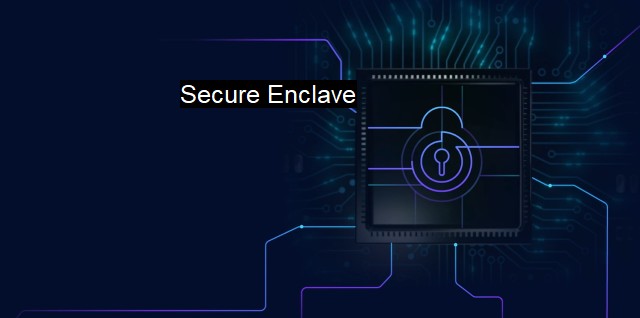What is Secure Enclave?
Safeguarding Sensitive Data: The Role of Secure Enclave in Cybersecurity
Secure Enclave is a term broadly used within the cybersecurity industry, particularly in relation to hardware-based key management and storage. It defines an isolated, protected area within a device's main processor, developed with superior levels of security measures. This innovative technology's central purpose is to enhance protection against potential external software-based attacks.The Secure Enclave, as a separate hardware component on a device’s main processor chip, is crucial for secure data processing and storage. Because of this physical separation, the Secure Enclave has a distinct operating environment, which is inaccessible from the remainder of the system, shielding sensitive user information from being compromised. This unique partition is fortified with cryptographic keys developed during the chip manufacturing process, adding an additional layer of security. Hence, even if a malevolent actor gains total control of the device's OS, the user's sensitive data remains secure within the Secure Enclave.
Integral to the Secure Enclave's design is the encryption and decryption of user's sensitive data. This detail is processed only within the boundaries of the Secure Enclave, powered by hardware-based keys. These keys are unique to each device and are neither accessible by any part of the system nor directly by the user.
To effectively provide enhanced user authentication security and protect vital information, the Secure Enclave works profoundly with biometric authentication mechanisms, including Touch ID or Face ID associated with Apple devices. By ensuring such integral security parameters, the Secure Enclave guarantees that the pattern of one's fingerprint or facial recognition data remains confidential. these biometric templates never leave the device and are not backed up to external servers or the iCloud, significantly reducing the risk of this critical user data being mishandled or abused in any possible way.
In the context of antivirus systems, Secure Enclave plays a pivotal role. By constituting additional protection capabilities for device storage, this system assists in mitigating against threats or hacks that attempt to exploit weaknesses in software and compromise user data. The conventional firewall, antivirus, or antimalware technologies mainly focus on software protection layers, while the Secure Enclave adds a dimension of hardware-focused advanced protection. This approach reinforces the overall antivirus strategy, ensuring unparalleled protection against numerous insider and outsider software-based attacks.
Despite its advantages, it is crucial not to consider Secure Enclave as a foolproof system. As with any aspect of cybersecurity, it remains susceptible to potential vulnerabilities and is only one part of a robust, multi-layered threat detection and neutralization system. It gives hackers a tougher barrier to cross, but it doesn't conquer all, requiring the integration of other security tools to solidify protection.
This premise reinforces the importance of regular system updates. Hardware continues to evolve and become more sophisticated, and as a result, new weaknesses can emerge. Regular system updates often contain critical tweaks or patches that counter newly discovered security vulnerabilities. Refraining from such updates can lead to increased risks of exploitation, thus weakening the purpose of Secure Encclave.
In the ever-evolving cybersecurity landscape, the Secure Enclave has showcased an advanced technological approach to shielding crucial user data. Its application, despite its inalienable vulnerabilities, establishes the significance of an armor-clad ecosystem that's resilient and effective against mounting cyber threats. It stands as a barrier between the hacker and the user, securing the delicate fragments of personal data, effectively raising the bar in the hardware security paradigm. Thus, the Secure Enclave is an indispensable ally enhancing data security efforts, and works parallely alongside other steady security measures.

Secure Enclave FAQs
What is a secure enclave in cybersecurity?
A secure enclave is a secure and isolated area within a device's hardware or software that provides an additional layer of security for sensitive data, such as encryption keys. It is designed to prevent unauthorized access to the data by external entities or even other parts of the device's system.How does a secure enclave protect against malware and viruses?
Secure enclave technology provides protection against malware and viruses by ensuring that sensitive data is stored in a protected and isolated environment that is inaccessible to any unauthorized parties, including malware or viruses. Additionally, the secure enclave can verify the authenticity of software or firmware updates, ensuring that no malicious code is installed.Are all devices equipped with a secure enclave?
No, not all devices have a secure enclave. It is a feature that is typically found in newer devices, particularly those that are designed for increased security, such as smartphones or laptops with biometric authentication.Can a secure enclave be hacked?
While no security measure is completely foolproof, secure enclave technology has proven to be a highly effective way of protecting against cyberattacks. The technology is designed to prevent outside access to sensitive data, making it extremely difficult to hack. However, it is still possible for sophisticated hackers to find and exploit vulnerabilities, so it is important for security teams to continue to monitor and update their systems to stay ahead of potential threats.| | A | | | B | | | C | | | D | | | E | | | F | | | G | | | H | | | I | | | J | | | K | | | L | | | M | |
| | N | | | O | | | P | | | Q | | | R | | | S | | | T | | | U | | | V | | | W | | | X | | | Y | | | Z | |
| | 1 | | | 2 | | | 3 | | | 4 | | | 7 | | | 8 | | |||||||